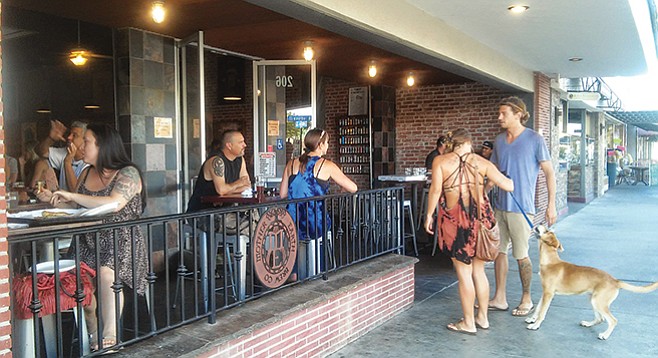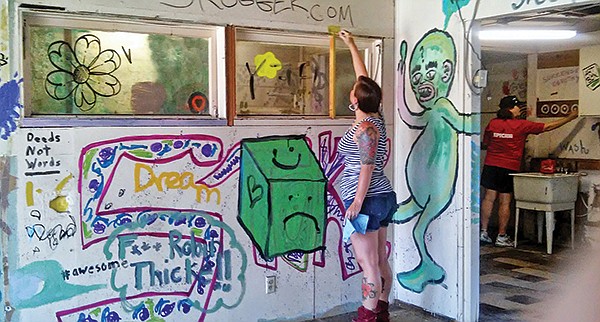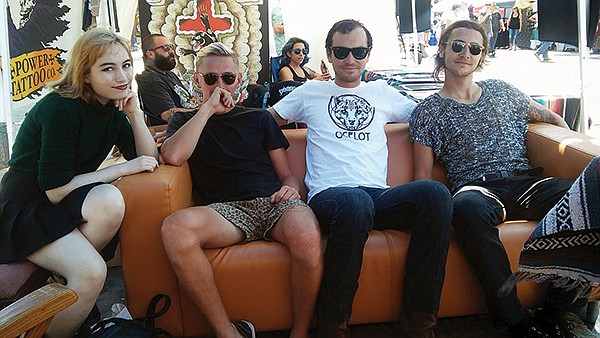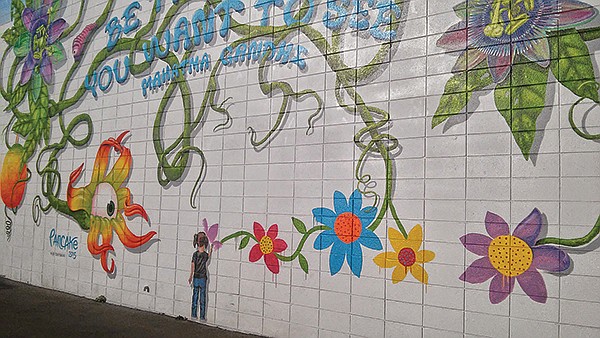 Facebook
Facebook
 X
X
 Instagram
Instagram
 TikTok
TikTok
 Youtube
Youtube

Kat Woronowicz Johnson, a professional photographer, lived in Bankers Hill for more than five years. She loved the vibrant neighborhood with its proximity to downtown, parks, and hip places to eat and sip coffee.

Then she fell for a guy who lived in Vista.
“I thought my social life was over when I moved to Vista to live with Esan,” Woronowicz Johnson laughed. “I never, ever thought I would end up living here.”
Woronowicz Johnson eventually married her Vista-born boyfriend and they are raising a baby daughter in the North County hub along with 97,000 other people. She compared the downtown Vista area vibe to Hillcrest 20 years ago.
“The weather is the best of San Diego, the housing is affordable, and I can see our daughter growing up here,” she said. “I like the proximity to L.A. so I can work, and I don’t think Vista will get too trendy. It’s more real, and I kind of like that it’s still sketchy in some parts.”
In the 1980s, Vista was indeed sketchy. More than 1000 gang members called it their home turf. Today, the Vista Homeboys are the only recognized gang left, with about 200 active members.

The graffiti that once tagged most buildings in the downtown area are now painted over with murals by Chor Boogie, a San Francisco–based spray painter who grew up in Vista, and by local school children.
High-rise apartments are popping up along the South Santa Fe corridor where historically Mexican bodegas and car-parts stores dotted the main thoroughfare. The farm-to-table movement has arrived in Vista with restaurants such as the Flying Pig Pub & Kitchen leading the way, and the city is a craft-beer hub.
Many in Vista credit the beer business for spurring a renaissance in their town. According to a 2014 city report, the industry provides $272 million in annual revenue and supports 850 jobs in North County, an area that includes Vista.
Kevin Ham, Vista’s economic development director, said that people come to Vista with the intention of dropping some beer dollars, and other businesses benefit. “The downtown businesses report a threefold business increase since the breweries came to town,” he said. “It’s amazing what craft beer has done for our economy.”
Ham lists Mother Earth Brew Co., Belching Beaver Brewery, Iron Fist Brewing Co., and Aztec Brewery as the local breweries with the most brand recognition and distribution. “Some breweries have found Downtown to be a complement to their expansion plans or their first entry into the market place,” Ham said. “These decisions are made by the companies based on their business plan and how they decide to expand their brand. For example, Stone [in Escondido] is involved in production, tasting rooms, distribution, food service, and may even consider a hotel. Other breweries may be content with one tasting room.”
A ghost town no longer

At a recent street fair, Vista brothers Jared and Jorden Heidt relaxed on an orange couch they schlepped from their record-producing office Lavender House located on South Santa Fe. They handed out stickers, business cards, and free T-shirts. They talked to aging skaters with families in tow and to teenagers about their record label. The young men and their friends gave off a cool, urban bohemian air.

“Vista is a happening place and the business community is welcoming to artists,” said Jorden. “Musicians are coming out of the woodwork and playing in the bars here in town. The transformation has been incredible. It’s taken some time, but Vista is finally a place where you want to live.”
Jorden, 24, said that, while growing up, there wasn’t much to do in the city, but things are changing.
“Back ten years ago, Vista was a ghost town,” he said. “Now, with the arrival of the breweries, the town has been accepting of skate shops and artistic endeavors such as our record label. There’s more music, more venues, and it almost feels like a mini Hollywood for artists. It’s a different time for Vista now. We’re glad we waited it out.”
Goodbye, Mom and Pop
Of course not everyone is thrilled with the changes in Vista. Ron Morese, 30, moved to Vista with his parents from Orange County at the age of 3 and still remembers the stop signs instead of lights and the non-existent traffic.
“It was very calm, a quiet countryside with horse trails and friendly neighbors,” he said. “You could see the stars in the sky, and the pollution was minimal. There was an array of local businesses and minimal corporatism. It stayed that way for quite some time.”
Morese isn’t quite sure when the changes started to happen, but he said “the pendulum eventually began to shift to the other side.... Still living in Vista, I now deal with excessive traffic, angry people, and extremely uneducated youth. I saw a half-cent tax increase a few years back, claiming that the funds were to be put toward a ‘downtown redevelopment’ plan. From that point, I saw the city spend $55 million on one excruciatingly painful eyesore of a Civic Center, even changing the street name of Escondido Avenue to Civic Center Drive,” he said. “Three million dollars of that went to the architect Carrier Johnson. Within one month, the city’s in-house lunch program went belly up, so I quickly saw that as a mismanaged plan much like the Civic Center itself.“
Speaking of the redevelopment plan in the “downtown Vista Village” area, Morese pointed out that it was once home to several mom-and-pop businesses and a lumber depot.
“Now it’s nothing but what corporate entities can sustain, and sometimes not even they can sustain business. I see our downtown area riddled with Panda Express, a corporate burger chain known as Five Guys, a tiny and overpriced water park, and a large bank/home mortgage office, and... Burger King, amongst other corporate businesses. There have been a few small places that have tried to survive, but lease agreements are just too high for any educated businessman or businesswoman to take that less than promising risk.”
Morese said he’s not much of a beer aficionado, but he appreciates the local businesses nonetheless.
“They have created not only more of a local economy, but it has also pushed people to support their neighbors, as it was at one point in the not-so-distant past,” he said. “It creates a comradery of business people and the like — places where one can go to meet their fellow neighbors, bring their dog, and have a laugh or two over a couple of pints of some nitro beers. It has, and I hope it continues to push that mentality ‘support local’ while knowing exactly who you are supporting.”
Growing, not losing, charm
City-council candidate Victoria Waufle has watched the changes in Vista take place over 35 years.
“When I first arrived in Vista as a divorced single mom in 1976, I found some brand new apartments and moved in,” she says. “Little did I know that Los Angeles Avenue was the barrio and home to the Vista gangs,” she said. “I was so naive back then.”
She later remarried and bought a home that she has lived in for 27 years.
Waufle, who is a lay minister for the Faith Evangelical Lutheran Church, believes that Vista is on the cusp of changing into the city it was supposed to be a decade ago.
“Vista is growing but not losing its charm,” she said, sipping a local beer on a Main Street restaurant patio. “It has a different feel from the other North County cities. It’s actually become a destination spot....
“No place is perfect. I understand people have been frustrated by the very slow growth. But in the end I think they will see that it’s been worth it.”


Kat Woronowicz Johnson, a professional photographer, lived in Bankers Hill for more than five years. She loved the vibrant neighborhood with its proximity to downtown, parks, and hip places to eat and sip coffee.

Then she fell for a guy who lived in Vista.
“I thought my social life was over when I moved to Vista to live with Esan,” Woronowicz Johnson laughed. “I never, ever thought I would end up living here.”
Woronowicz Johnson eventually married her Vista-born boyfriend and they are raising a baby daughter in the North County hub along with 97,000 other people. She compared the downtown Vista area vibe to Hillcrest 20 years ago.
“The weather is the best of San Diego, the housing is affordable, and I can see our daughter growing up here,” she said. “I like the proximity to L.A. so I can work, and I don’t think Vista will get too trendy. It’s more real, and I kind of like that it’s still sketchy in some parts.”
In the 1980s, Vista was indeed sketchy. More than 1000 gang members called it their home turf. Today, the Vista Homeboys are the only recognized gang left, with about 200 active members.

The graffiti that once tagged most buildings in the downtown area are now painted over with murals by Chor Boogie, a San Francisco–based spray painter who grew up in Vista, and by local school children.
High-rise apartments are popping up along the South Santa Fe corridor where historically Mexican bodegas and car-parts stores dotted the main thoroughfare. The farm-to-table movement has arrived in Vista with restaurants such as the Flying Pig Pub & Kitchen leading the way, and the city is a craft-beer hub.
Many in Vista credit the beer business for spurring a renaissance in their town. According to a 2014 city report, the industry provides $272 million in annual revenue and supports 850 jobs in North County, an area that includes Vista.
Kevin Ham, Vista’s economic development director, said that people come to Vista with the intention of dropping some beer dollars, and other businesses benefit. “The downtown businesses report a threefold business increase since the breweries came to town,” he said. “It’s amazing what craft beer has done for our economy.”
Ham lists Mother Earth Brew Co., Belching Beaver Brewery, Iron Fist Brewing Co., and Aztec Brewery as the local breweries with the most brand recognition and distribution. “Some breweries have found Downtown to be a complement to their expansion plans or their first entry into the market place,” Ham said. “These decisions are made by the companies based on their business plan and how they decide to expand their brand. For example, Stone [in Escondido] is involved in production, tasting rooms, distribution, food service, and may even consider a hotel. Other breweries may be content with one tasting room.”
A ghost town no longer

At a recent street fair, Vista brothers Jared and Jorden Heidt relaxed on an orange couch they schlepped from their record-producing office Lavender House located on South Santa Fe. They handed out stickers, business cards, and free T-shirts. They talked to aging skaters with families in tow and to teenagers about their record label. The young men and their friends gave off a cool, urban bohemian air.

“Vista is a happening place and the business community is welcoming to artists,” said Jorden. “Musicians are coming out of the woodwork and playing in the bars here in town. The transformation has been incredible. It’s taken some time, but Vista is finally a place where you want to live.”
Jorden, 24, said that, while growing up, there wasn’t much to do in the city, but things are changing.
“Back ten years ago, Vista was a ghost town,” he said. “Now, with the arrival of the breweries, the town has been accepting of skate shops and artistic endeavors such as our record label. There’s more music, more venues, and it almost feels like a mini Hollywood for artists. It’s a different time for Vista now. We’re glad we waited it out.”
Goodbye, Mom and Pop
Of course not everyone is thrilled with the changes in Vista. Ron Morese, 30, moved to Vista with his parents from Orange County at the age of 3 and still remembers the stop signs instead of lights and the non-existent traffic.
“It was very calm, a quiet countryside with horse trails and friendly neighbors,” he said. “You could see the stars in the sky, and the pollution was minimal. There was an array of local businesses and minimal corporatism. It stayed that way for quite some time.”
Morese isn’t quite sure when the changes started to happen, but he said “the pendulum eventually began to shift to the other side.... Still living in Vista, I now deal with excessive traffic, angry people, and extremely uneducated youth. I saw a half-cent tax increase a few years back, claiming that the funds were to be put toward a ‘downtown redevelopment’ plan. From that point, I saw the city spend $55 million on one excruciatingly painful eyesore of a Civic Center, even changing the street name of Escondido Avenue to Civic Center Drive,” he said. “Three million dollars of that went to the architect Carrier Johnson. Within one month, the city’s in-house lunch program went belly up, so I quickly saw that as a mismanaged plan much like the Civic Center itself.“
Speaking of the redevelopment plan in the “downtown Vista Village” area, Morese pointed out that it was once home to several mom-and-pop businesses and a lumber depot.
“Now it’s nothing but what corporate entities can sustain, and sometimes not even they can sustain business. I see our downtown area riddled with Panda Express, a corporate burger chain known as Five Guys, a tiny and overpriced water park, and a large bank/home mortgage office, and... Burger King, amongst other corporate businesses. There have been a few small places that have tried to survive, but lease agreements are just too high for any educated businessman or businesswoman to take that less than promising risk.”
Morese said he’s not much of a beer aficionado, but he appreciates the local businesses nonetheless.
“They have created not only more of a local economy, but it has also pushed people to support their neighbors, as it was at one point in the not-so-distant past,” he said. “It creates a comradery of business people and the like — places where one can go to meet their fellow neighbors, bring their dog, and have a laugh or two over a couple of pints of some nitro beers. It has, and I hope it continues to push that mentality ‘support local’ while knowing exactly who you are supporting.”
Growing, not losing, charm
City-council candidate Victoria Waufle has watched the changes in Vista take place over 35 years.
“When I first arrived in Vista as a divorced single mom in 1976, I found some brand new apartments and moved in,” she says. “Little did I know that Los Angeles Avenue was the barrio and home to the Vista gangs,” she said. “I was so naive back then.”
She later remarried and bought a home that she has lived in for 27 years.
Waufle, who is a lay minister for the Faith Evangelical Lutheran Church, believes that Vista is on the cusp of changing into the city it was supposed to be a decade ago.
“Vista is growing but not losing its charm,” she said, sipping a local beer on a Main Street restaurant patio. “It has a different feel from the other North County cities. It’s actually become a destination spot....
“No place is perfect. I understand people have been frustrated by the very slow growth. But in the end I think they will see that it’s been worth it.”
Comments